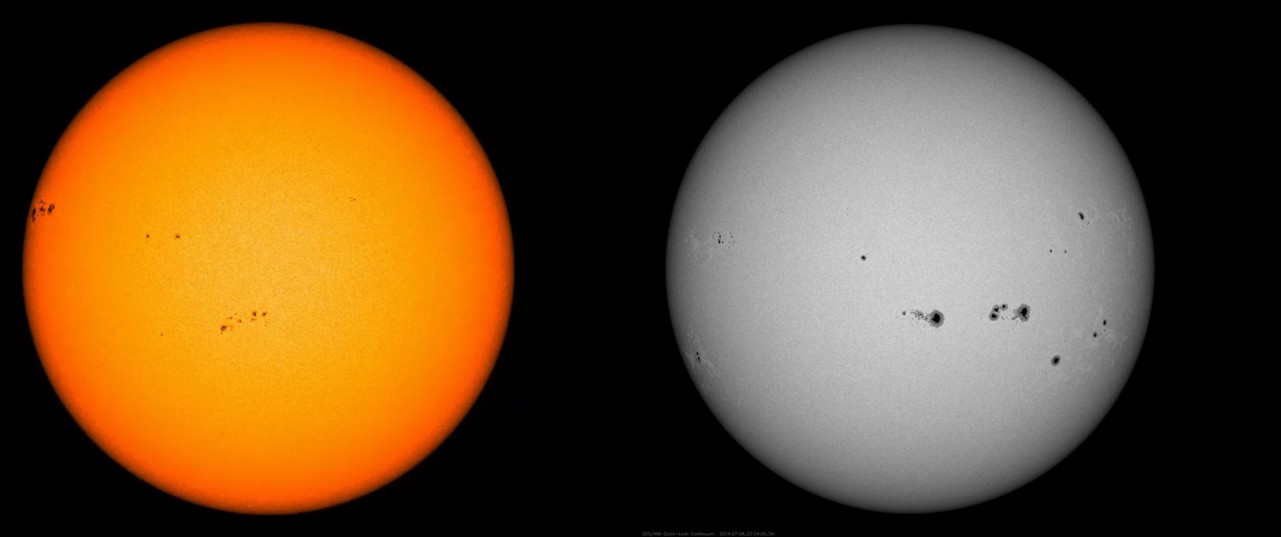Assistant Professor Tatiana Podladchikova of the Skoltech Space Center (SSC), whose field is space weather, recently gave a presentation, Embraced by the Sun, to a large audience at the Park Zaryadye Nature Center (Tuesday, June 18). During the presentation, she outlined what space weather is and how it affects Earth, the Solar System, and human civilization – especially technology. She also talked about how, using modern instruments, we can predict space weather both in the short and long term.
For many people, space weather is an abstract phenomenon; the first thing that one tends to think of upon hearing that phrase is “Aurora Borealis,” the beautiful lights that illuminate the polar night skies in hues of red, blue and green. However, space weather is a much more complex phenomenon in the way that it influences our technological civilization.
The first time that humanity became truly aware of the potential effects that space weather could have on a modern civilization was in the mid-nineteenth century. During that period, the telegraph was the main means of communication between governments, businesses, and occasionally citizens. In 1859, a very large solar flare (an ejection of electromagnetic radiation) struck the Earth knocking out telegraphs on a mass scale, and the Aurora Borealis was visible in tropical regions as far south as Cuba; the solar flare even left traces in the Greenland ice. This became known as the Carrington Event, named after the British scientist, Richard Carrington, and it remains one of the key examples of space weather affecting human civilization.
The danger has not passed; in fact, as we become more advanced and reliant on technology, space weather has an even greater potential to disrupt the stability of our civilization now than ever before. Should a solar flare on the scale of the Carrington Event hit Earth again, the cost to the world economy is estimated to run into the trillions of dollars. We caught up with Professor Podladchikova to talk about her research and field of work in further detail.
Describe your field of expertise and the focus of your research.
Imagine that you wake up in the morning, it’s mid-March, it’s cold outside, and you realize that your central heating isn’t working. You go to the kitchen to make coffee, but realize that the kettle isn’t working either. Nor is the refrigerator, any of the lights, or the internet. Outside, it’s the same story. The traffic lights aren’t working, factories are at a standstill, and so are the airports, schools, and electrical transportation. Everything that supports a modern civilization has simply ground to a halt. This sounds like the beginning of an apocalyptic scenario, right?
Well, this actually happened in Canada back in 1989. A powerful geomagnetic storm shut off an entire power grid and caused a mass blackout. It disrupted the transistors due to currents originating from the Sun and 6 million people were left without electricity for a whole night. The cost of that particular geomagnetic storm was something in the range of $300 million, because the entire infrastructure collapsed and industry came to a standstill.
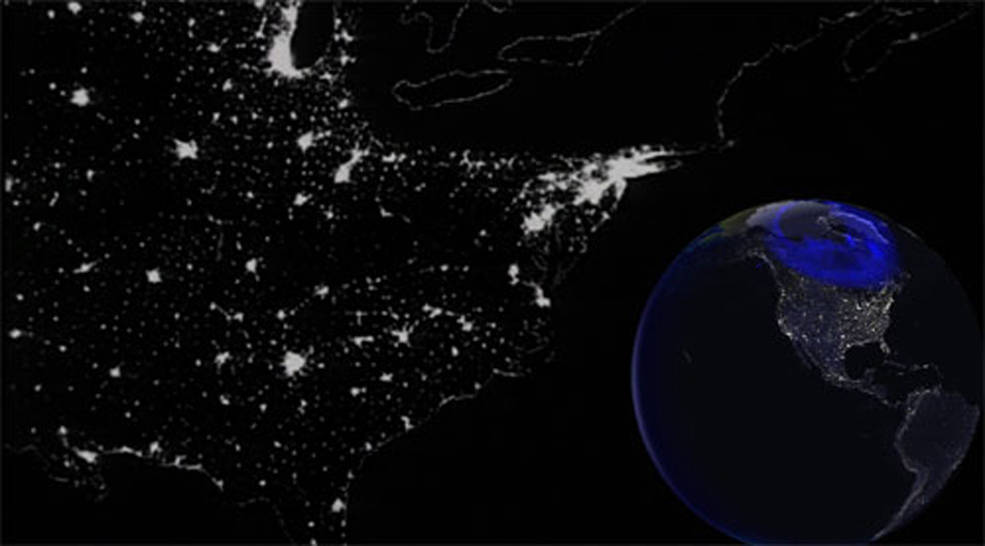
Image: “The Day the Sun Brought Darkness,” artist rendition of the 1989 blackout in Canada. Credit: NASA
A famous Russian scientist who is the founder of heliobiology (how the Sun affects living systems) said, “The Earth is always embraced by the Sun. The Sun’s mood is transferred to the Earth.”
The focus of my work is to understand how the energy from the Sun is transferred to the Earth, how we are affected, and how our technology is affected both on the Earth’s surface and in space. This consists of many different aspects of solar physics research that are related to understanding the core of the solar phenomena that we observe. We then apply that to the creation of space weather services to make accurate space weather predictions in order to mitigate the effects.
We can already help technology by understanding the processes on the Sun and by measuring solar events. We can now detect active events on the Sun and switch off satellite equipment in time to reduce the risk of damage, and if we see a potential danger, a launch can be cancelled as a result; this is connected to many aspects of space weather.
Solar flares are bursts of electromagnetic radiation, these bursts take only eight minutes (light speed) to reach Earth, and we focus on the x-rays to measure them. When a solar flare reaches Earth, it can interfere with the many radars used for radio-communications. An example of this is November 2005, when a strong solar storm grounded Swedish air traffic after the aircraft disappeared from the radar systems.
Another example is that we recently launched a satellite into space and needed to plan its reentry. Our atmosphere can become very heated due to solar activity, which causes it to expand, and a satellite can lose its orbit – this is known as atmospheric drag. As a result, every three weeks we have to bring a spacecraft back to its orbit during peak of Sun activity. In addition, there is a lot of space debris, much of it very small; if a spacecraft unexpectedly changes its orbit and encounters even a small piece of this debris, it would be equivalent to hitting a bomb because of the high speed.
Galactic cosmic rays are another dangerous form of space weather. Originating from other galaxies, they enter the solar panels of geostationary satellites (satellites at an altitude of 36-40,000 kilometers on a stationary line); when this happens, we can lose the spacecraft and it can fall into the ocean. There are many examples of this happening, such as the satellite, Galaxy 10 in 2010. A satellite in geostationary orbit can be affected, airplanes are then affected, and a GPS signal can be lost and the aircraft is essentially blind. The level of radiation in the atmosphere can also affect flights; in Russia, pilots at high latidudes have special cards that register the number of hours they can spend in order not to exceed the safety limit of radiation. They do this at high latitudes because it is very dangerous. At a middle latitude (Moscow, for example), a very strong solar flare can be the equivalent to one hundred hospital x-rays. Aside from the dangers of radiation, the cost of changing one unplanned flight starts at $100 thousand.
Going back to spacecraft, solar flares like the one I’ve just mentioned are very rare but show highlight the hazards of space travel. During one of the last two Apollo missions to the Moon – Apollo 16 and 17 – there was a very powerful solar flare. Had the astronauts been caught in this, they would have received a mortal dose of radiation.
If we are talking about geostationary satellites, they are generally protected by the Earth’s magnetosphere; there are many satellites there, especially telecommunications satellites. The magnetic field also protects life on Earth. However, a danger can arise when solar wind and the interplanetary magnetic field create sufficient pressure to push the boundary of the Earth’s magnetosphere to a lower altitude than the satellites’ orbit, leaving the geostationary satellites without natural shielding.
If you get closer to Earth, variations in the magnetic field during geomagnetic storms create geomagnetically induced currents that affect all land-based technological systems such as pipelines, electricity (the Quebec blackout), railway lights – red turning to green when it’s not supposed to and vice versa. In the near future, space weather prediction will have an important value for the safety of autonomous transport, as a strong geomagnetic storm could stop self-driving cars. During the Vietnam War, around 25 mines off the Vietnamese coast detonated spontaneously and nobody knew the reason why. Actually, they had reacted to magnetic field variations due to a powerful coronal mass ejection from the Sun. This could repeat itself.
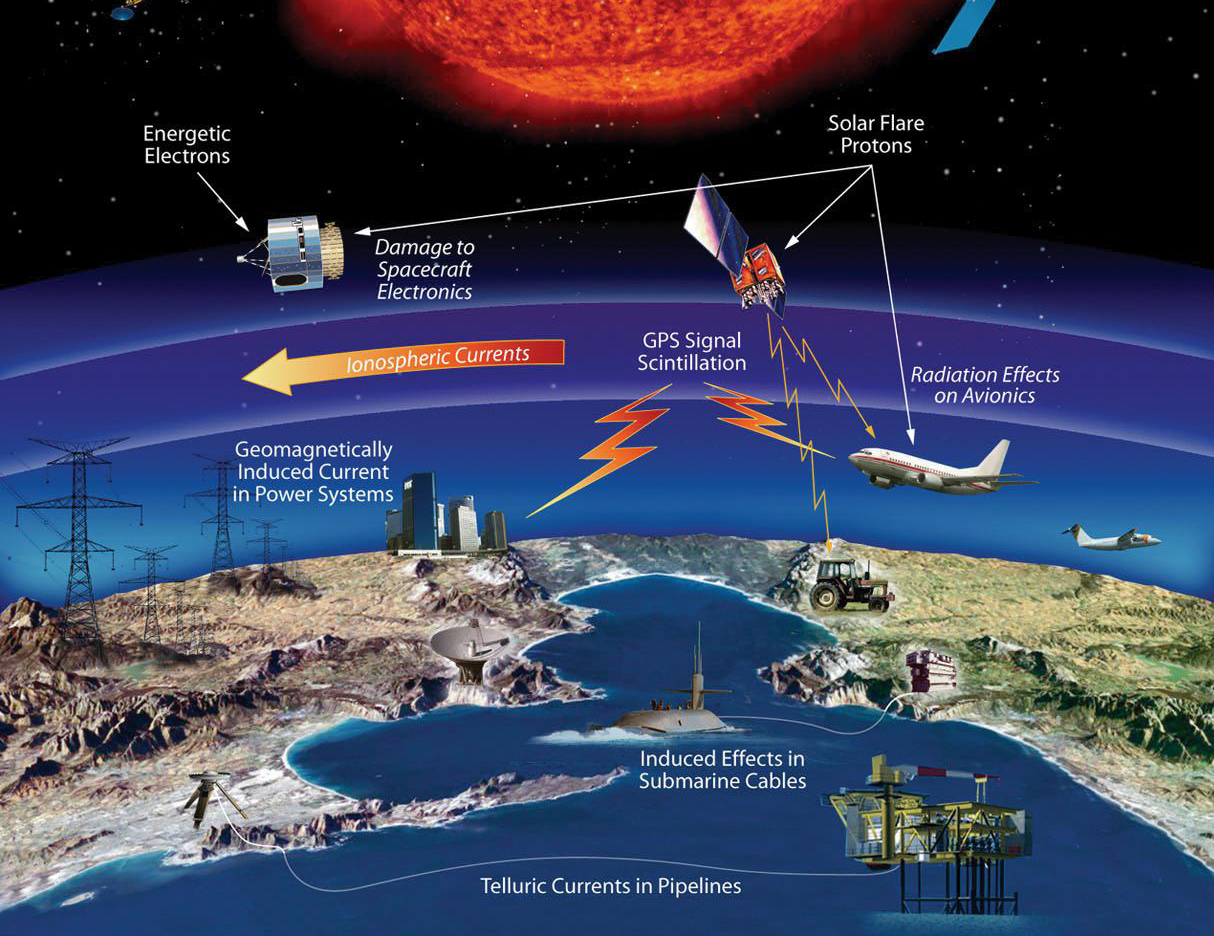
Image: Technological and infrastructure affected by space weather events. Credits: NASA
Could you go into detail on protections from space weather?
Here on Earth, we are lucky as we are naturally protected by the magnetic field; it deflects most galactic cosmic rays in the near-Earth environment, which are then absorbed by the atmosphere. However, during strong eruptive solar events, radiation can reach Earth, posing risks to astronauts and technology. For instance, in September 2017, two of the strongest solar flares over the last 12 years forced the ISS crew – 400 kilometers above the Earth – to go to the special shelter onboard. However, this is not really a shelter; they just have a room with more electronics and thicker walls. If you are outside the magnetosphere, things get really crazy and that’s why space travel is so dangerous. For long-term space flight, we need a special shielding.
Currently, there are two different approaches to protect against radiation. One is called passive shielding, where we place material between the source of radiation and a human. While it can mitigate the incoming radiation, it makes spacecraft heavy and expensive to launch. Additionally, passive methods generate so-called secondary radiation that could be even more harmful than the galactic cosmic rays themselves.
Another approach is based on so-called active radiation shielding inspired by Earth’s magnetic field that can deflect and trap particles of incoming radiation. However, this is quite a futuristic technology. To deflect the most dangerous galactic cosmic rays you would need the force of the Earth’s entire magnetic field.
The Sun is the source of light, heat and life on Earth, but active events on it strongly affect short-wave radio communications and navigation. During the Second World War, people understood that there were problems related to the conditions in the atmosphere; every day, they would look at solar conditions and then decide on what frequency to send signals.
Today, during active events on the Sun, we can switch off sensitive satellite equipment to avoid imminent disruptions. Another thing is just to cancel any satellite maneuvers, launches, and polar flights – there can be no launches without favorable space weather conditions.
How do you predict space weather?
I would describe the method of prediction as taking two different approaches and then combining them. The first is a statistical method. What does this mean? Let us say that you go out into the street and start looking at cars and there are three numbers on each registration number – the question is, “What is the probability that the first two numbers will be the same?” This is a simple mathematical thing from probability theory and it equates to one divided by ten (10%). This means that if you calculate for 300 cars, then 30 will have the same first two numbers. If you calculate 1000, the number will amount to 100, and so on. This is a very common approach, because it is easy to take a large amount of data and find regularities.
Another approach is based on a very strong physical idea or observable evidence, but it’s not as easy. In Ancient Greece, there was a man called Eratosthenes who was the head of the Alexandria library (Egypt). By chance, he discovered that in Syene, a city several hundred kilometers south of Alexandria on the Nile, objects cast no shadows during the summer solstice, whereas in Alexandria they did. Because of this, he worked out that the Earth is a globe and, knowing the distance between the cities, he made a very accurate calculation of the Earth’s radius. Later, another Greek repeated this experiment, made a mistake, and calculated the radius of the Earth incorrectly; Columbus would later use this during his exploration. Only Magellan, who did the first circumnavigation of the Earth, confirmed that Eratosthenes was correct. So why am I saying this? It’s to illustrate that there is the statistical approach and the approach that is based on physics where you can actually make observations. Alternatively, you can do a combination.
Today, many ground and space-based observatories and stations observe the Sun and interplanetary space. These observations are used for space weather predictions. If we see a large group of sunspots in the geo-effective solar latitude, we know that there is a risk that there will be a solar flare or a coronal mass ejection that could fly to Earth. We can expect the same group of sunspots to appear in 27 days (1 solar rotation) at the same place. This gives us time to make some decisions. If we see a groups of sunspots on the solar limb (on the left), we expect it to arrive at a geo-effective solar latitude within 5-6 days. In such a case, it is better to postpone a launch, as the probability of a solar flare is high. If sunspots are present, it’s a huge risk to conduct a launch because a solar flare can reach the Earth in 8 minutes and we already know the damage they can do.
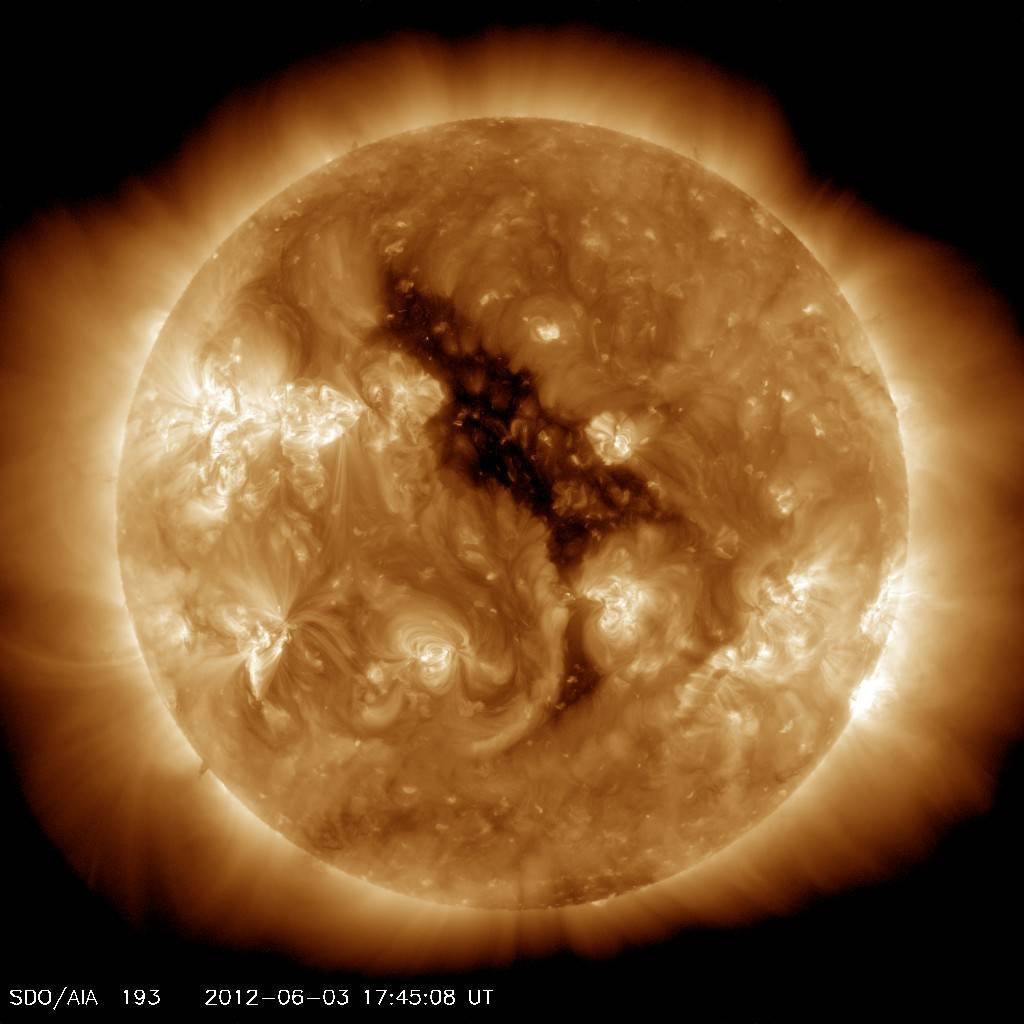
Image: Coronal hole. Credit: NASA
Yet another phenomenon is the so-called coronal hole (see above), a region on the Sun’s surface where the magnetic field is open and particles can escape into space. This is a fast solar wind stream, which can reach Earth within 1-5 days, and it serves as another means to make warnings. When we detect a coronal mass ejection – a giant plasma cloud propelled from the Sun at 100 to 3,500 km/s – by simple observation, we can tell if it is going to hit us or not. If from the coronagraphs we see a plasma bubble from all sides, so-called halo coronal mass ejections, then we can expect a geomagnetic storm on Earth within 1-5 days. We can then apply this information to an operational forecast to save satellites orbiting Earth, and there have been cases where sensitive equipment was switched off. For example, in the year 2000, a period of a very high solar activity, ground operators saved a Russian spacecraft in this way, but many satellites had problems.
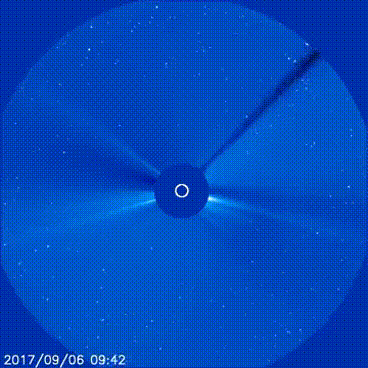
Image: Coronal mass ejection. Credit: NOAA Space Weather Prediction Center.
However, the detection of a coronal mass ejection doesn’t guarantee a geomagnetic storm. Within several days, it approaches the Earth’s magnetic field, but the magnetic field won’t allow energy to enter, except under certain conditions. The Earth’s magnetosphere opens only if the interplanetary magnetic field, which is a component of the solar magnetic field, is dragged out from the solar corona by the solar wind and in the opposite direction to the Earth’s magnetic field. In that case, a magnetic reconnection happens. Solar wind continues to blow and reconnected magnetic lines are shifted to the night-side of the Earth. There they reconnect once again and part of the energy is ejected into space, and part is sent along the magnetic field lines to Earth’s magnetic poles. That’s when we see the Aurora Borealis. Energetic particles coming to Earth from the Sun are trapped by Earth’s magnetic field and a substantial amount of energy is transferred into the magnetosphere. The entire magnetosphere becomes disturbed and this state is characterized as a “geomagnetic storm.” The primary measure of intensity of a geomagnetic storm is the strength of the ring current created around the Earth, which decreases the Earth’s magnetic field. In reality, we live at the center of a big electricity station.
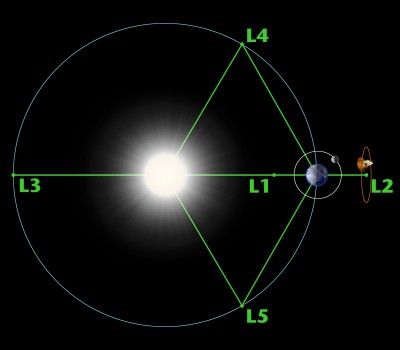
Image: Lagrange points. Credit: NASA
In order to know for sure whether a magnetic reconnection has happened and the Earth’s magnetosphere is open for the solar energy to enter, we can look at the so-called libration point L1, which is located 1.5 million km from the Earth. When the energy reaches that point but hasn’t yet reached Earth, the data is transferred to us by means of a radio channel; that provides us with the opportunity for a short-term forecast with a lead time of several hours.
Of course, a lot of scientists around the globe work on space weather predictions from Sun to Earth and beyond, combining observations with complicated physical and mathematical models, many of which are implemented for operational purposes.
To sum up, what role does your research have for industry?
First, we need to understand that the source of space weather is the Sun and that active events on the Sun drive space weather. According to NASA, space weather refers to conditions on the Sun – in the solar wind – that permanently blows from the solar corona, solar atmosphere, and into Earth’s magnetosphere (ionosphere and thermosphere) that can influence the performance and reliability of space-borne and ground-based technological systems and can endanger human life or health. Understanding, forecasting and mitigation of extreme space weather events is becoming more and more important, as our modern society increasingly relies on satellite systems for communication, navigation, Earth/weather/climate observations, catastrophe management, economic transactions, etc., and is thus highly vulnerable to space weather effects. This is also reflected in the foundation of the ESA’s Space Situational Awareness Programme and NASA activities (US congressional activities) where space weather is a key area with the aim of delivering space weather services to end users.
Space weather is a new, but applied discipline. It requires continuous monitoring of the Sun and space environment and it is directed toward development of service products for specific users. However, to develop and improve the necessary space weather services, we need to do the research in solar and terrestrial physics. We still have many more steps to take to understand the Sun and Sun-Earth relations. In order to benefit from solar-terrestrial research, it is important to use research-to-operations research, which brings together the forefront of research with applications. This brings benefits through the delivery of new public and commercial space-based services and development of new technologies.
Contact information:
Skoltech Communications
+7 (495) 280 14 81

